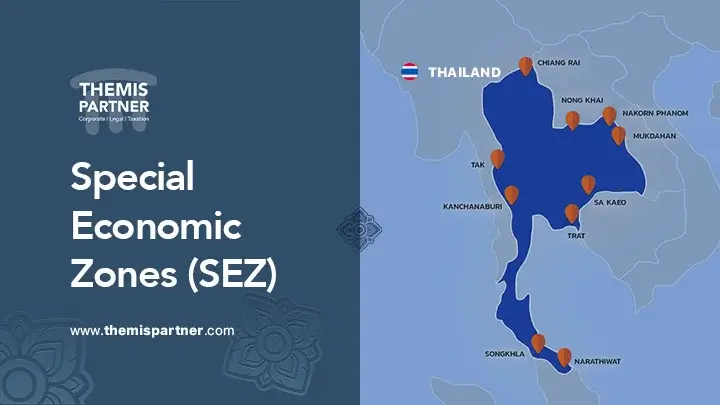Special Economic Zones (SEZ) in Thailand have fueled over 15% growth in manufacturing exports in the past year, transforming regions like Tak and Sa Kaeo into vital industrial gateways for Southeast Asia.
What sets Thailand’s SEZs apart right now is not only robust tax holidays and full foreign land ownership but also new policy shifts favoring tech, logistics, and advanced manufacturing.

With updated incentives coming into effect for 2025, including reduced corporate income tax rates as low as 3% in Southern provinces, understanding SEZ frameworks is essential for capturing these opportunities.
Key Takeaways
- Thailand’s Special Economic Zones (SEZs) offer targeted incentives including up to 8 years corporate income tax holidays, tax rates as low as 3 percent, and full foreign land ownership within designated zones.
- SEZs are strategically located near borders for trade connectivity and rapid export, with key sites in Tak, Sa Kaeo, and Songkhla supporting agro-industry, manufacturing, and logistics.
- Eligible sectors include manufacturing, agriculture, logistics, digital, and medical industries, with over 15% export growth from SEZs in the past year and new opportunities for digital and biotech clusters.
- Investors benefit from streamlined processes such as one-stop administrative centers, relaxed foreign labor rules, and access to advanced infrastructure for fast-track business setup.
- Compliance requires businesses to separate SEZ and non-SEZ income, maintain up-to-date records, and closely monitor policy changes to retain incentives and avoid penalties.
- Core regulations derive from the Special Economic Zone Act B.E. 2558 and EEC Act B.E. 2561, with oversight by government bodies including the NESDC, BOI, and IEAT, licensing and government-approved sector participation are mandatory.
- Key risks include land use challenges, labor regulations, and policy inconsistency, so due diligence, ongoing regulatory review, and regular internal audits are critical for sustainable operations.
- Proactive alignment with targeted sectors and robust compliance strategies position businesses to capture the maximum benefits and growth potential of Thailand’s SEZ framework in 2025 and beyond.
Table of Contents
Thailand SEZs: Concept, Structure & Policy
What Defines SEZs in Thailand?
Special Economic Zones (SEZ) in Thailand are specific regions established to promote investment, develop border trade, and reduce economic gaps between provinces.
They are guided by a clear legal structure and governed by:
- The Special Economic Zone Act B.E. 2558 and EEC Act B.E. 2561
- Oversight bodies such as the NESDC (National Economic and Social Development Council), BOI (Board of Investment), and IEAT (Industrial Estate Authority of Thailand)
- Collaborative roles from both national and local agencies
SEZs prioritize:
- Regional development and cross-border economic integration
- Site selection near borders for trade connectivity and infrastructure expansion
For additional detail, visit the Thailand Board of Investment and the NESDC.
Key SEZ Locations and Strategic Value
Thailand’s major SEZs are strategically placed in provinces including:
- Tak
- Sa Kaeo
- Songkhla
- Mukdahan
- Chiang Rai
- Nakhon Phanom
- Nong Khai
- Narathiwat
- Kanchanaburi
- Trat
Locations are chosen for unique advantages:
- Proximity to border checkpoints and major road/rail corridors
- Easy access to regional and international markets
Notably, zones like Tak and Sa Kaeo lead in agro-industry, while Songkhla excels in logistics and cross-border trade.
SEZs in Thailand offer investors a legal framework, clear governance, and highly strategic locations shaped for international trade, empowering businesses to act with confidence.
SEZ Investment Incentives in Thailand
Fiscal & Non-Fiscal Benefits for Investors
Businesses investing in Special Economic Zones (SEZ) in Thailand gain a host of fiscal and operational benefits designed to drive competitiveness and growth.
Key fiscal incentives include:
- Corporate income tax holidays of up to 8 years, followed by a reduced 5-year half-rate
- Reduced corporate income tax (as low as 3% for select southern SEZs from 2024–2026)
- Import and export duty waivers covering machinery, raw materials, and goods for export
- Personal income tax reductions for skilled workers (down to 0.1% and 3% withholding rates)
Investors also enjoy:
- 100% foreign ownership and land rights for business facilities
- Streamlined administrative processes through one-stop service centers
- Relaxed rules on employing foreign labor
- Access to modern logistics and infrastructure
The Eastern Economic Corridor (EEC) offers enhanced incentives and streamlined entry for targeted industries.
Eligibility, Application & Compliance
Eligibility for SEZ incentives is tightly defined and sector-specific.
To qualify, companies must:
- Operate in government-targeted sectors such as electronics, agro-processing, or logistics
- Physically locate operations within approved SEZ boundaries
- Submit a detailed application with supporting documentation for licensing
Companies must also:
- Separate SEZ and non-SEZ income in reporting
- Maintain rigorous compliance with statutory requirements to avoid overlap penalties
- Monitor regulatory changes, as policy updates (like adjusted tax periods) may require prompt action
SEZ incentives in Thailand reward compliance and clear separation of activities. Businesses staying proactive benefit the most. For the greatest impact, align sector, location, and documentation from day one.
Top Industries & Opportunities in Thai SEZs
Leading Sectors in 2025
Key sectors thriving in Thailand’s Special Economic Zones (SEZs) for 2025 include:
- Manufacturing (notably electronics and automotive)
- Agro-processing and agriculture (including food export)
- Medical devices
- Logistics and tourism
Market data shows that SEZ manufacturing exports rose over 15% last year, with Tak and Sa Kaeo leading in electronics and automotive output. Agro-processing in Songkhla and Mukdahan sees high demand, driven by border trade with neighboring ASEAN countries.
Government support targets these sectors through:
- Tax reductions and duty exemptions
- Streamlined customs and special labor quotas
- Funding for infrastructure and innovation
SEZs act as growth engines, attracting investment and accelerating Thailand’s role in global supply chains.
Emerging Opportunities & Innovation Hubs
Recent government updates have expanded privileges for:
- Digital and automation clusters in EEC zones
- Biotech research and medical innovation hubs
- Logistics corridors linking Thailand directly to Cambodia, Laos, and Myanmar
Sector-switching is promoted, letting established manufacturers diversify into digital or healthcare with reduced compliance hurdles. Regional value-chain integration is prioritized, connecting SEZs with international partners for stronger export and sourcing capabilities.
To leverage these trends, focus on targeted industries, monitor government incentive changes, and explore cross-sector innovation via SEZ clusters.
SEZs now offer focused advantages in fast-growing sectors, giving businesses a launchpad for regional growth and innovation.
SEZ Regulatory Framework: Rules & Compliance
Core Laws, Licensing & Restrictions
Special Economic Zones (SEZ) in Thailand operate under the Special Economic Zone Act, B.E. 2558 and the Eastern Economic Corridor (EEC) Act, B.E. 2561.
Oversight is managed by key government bodies including the Office of the National Economic and Social Development Council (NESDC), Board of Investment (BOI), and Industrial Estate Authority of Thailand (IEAT).
Key requirements for SEZ participation include:
- Limiting activities to government-approved industries listed by the BOI or specific regulations
- Applying for sector-specific licenses, according to precise zone and industry targets
- Meeting location mandates: eligible operations and facilities must be physically located within SEZ boundaries
Businesses must follow detailed compliance obligations such as:
- Separate accounting for SEZ and non-SEZ income
- Timely regulatory reporting and declarations
- Observing prohibited activities and restrictions on sector access
For the most current statutes, visit the Official Thai Legislation Repository.
Compliance Challenges and Penalties
Failure to comply with SEZ rules can lead to loss of incentives or administrative penalties.
Typical compliance challenges include:
- Overlapping incentives with other government schemes, risking double benefits
- Incomplete or late reporting, especially audit requirements and tax separation
- Misclassifying income outside of SEZs or failing to monitor qualifying activities
Expert guidance emphasizes:
- Conducting regular internal audits
- Training accounting teams on sector eligibility
- Reviewing incentive overlaps before applying for new licenses
In summary, Thailand’s SEZ legal framework rewards high-compliance organizations while penalizing oversights. Precision in regulatory management drives true value for SEZ investors. Regular policy updates and internal reviews help businesses maintain eligibility and maximize incentives.
Investor Challenges & Opportunities in SEZs
Risks: Legal, Social & Operational
Investing in Thailand’s Special Economic Zones (SEZs) requires careful attention to unique risks that can affect project success from day one.
Key pain points for investors include:
- Land use and environmental issues, such as overlapping claims or limited safeguards for local communities
- Labor complexities: navigating quota rules, fair wages, and community integration
- Policy inconsistency, as key incentives may change without long-term notice
- Infrastructure gaps between zones, where logistics and utilities may lag behind expectations
Civil society groups and international agencies have urged stronger protections under the EEC Act and more uniform application of community rights. Monitoring recent regulatory updates and legal commentaries is essential.
Growth Strategies and Outlook
Proactive strategies empower businesses to turn SEZ risks into tangible opportunities:
- Conduct due diligence to verify eligibility, location-specific benefits, and sector fit
- Separate SEZ/non-SEZ income and maintain rigorous, transparent records to avoid overlap penalties
- Leverage one-stop administrative support for faster licensing and workforce mobilization
- Align with targeted sectors, such as electronics or logistics, where government support and export incentives are strongest
New SEZ policies for 2025 introduce lower CIT rates (down to 3 percent in the southern zones), allowing early movers to capture maximum tax savings.
Staying attuned to official policy changes and local stakeholder dynamics helps business owners reduce risk, plan long term, and align with Thailand’s evolving investment climate.
Clear action steps and robust compliance pave the way for sustainable growth in Thailand’s Special Economic Zones.
FAQ: Special Economic Zones (SEZ) 2025
How do SEZ incentives compare in ASEAN?
Thailand’s Special Economic Zones (SEZs) offer targeted tax holidays, 100% foreign ownership, and streamlined labor rules, which are competitive within the ASEAN region.
Key benchmark differences for investors include:
- Tax relief: Up to 8 years’ exemption plus lower corporate income tax rates (as low as 3% in southern SEZs from 2024–2026)
- Land ownership: Foreign businesses can own land outright in SEZs, unlike most other areas in Thailand and many ASEAN countries
- Flexibility: Simplified application procedures and access to foreign labor quotas are built in
Can foreigners own land in Thai SEZs?
Foreigners are permitted to hold full land ownership within designated SEZs for business operations such as factories and logistics hubs, subject to BOI approval.
Restrictions apply outside SEZ boundaries, and ownership is tied to operational projects within SEZs under regulations of the Special Economic Zone Act B.E. 2558.
Are benefits for services & tech or just manufacturing?
Recent policy shifts mean that service, technology, and digital businesses now qualify for specific incentives in addition to manufacturing.
Eligibility focuses on targeted sectors listed by the Board of Investment (BOI), including digital, logistics, medical devices, and R&D-intensive operations.
Key compliance risks for multinationals
Multinationals must monitor compliance closely to avoid:
- Overlapping incentives across schemes by tracking income streams separately
- Stringent audit and reporting obligations required for SEZ/non-SEZ activities
- Penalties for missing notifications or failing to maintain eligibility
A leading best practice: maintain dedicated accounting systems for SEZ operations and seek regular legal review to remain updated on regulatory changes.
Thailand’s SEZs empower investors with robust incentives and operational freedoms, but diligent compliance and sector eligibility review are critical for sustained benefit and risk mitigation.
Conclusion
Thailand’s Special Economic Zones give you a strategic advantage, unlocking tax incentives, streamlined operations, and prime access to Southeast Asian markets.
Seize the opportunity:
- Evaluate which SEZ sector aligns with your business model.
- Gather compliance documents and check zone-specific criteria.
- Consider leveraging one-stop service centers for faster setup.
- Separate SEZ and non-SEZ income to maximize benefits and minimize risk.
- Stay informed on policy updates to protect long-term gains.
If you’re ready to move forward, contact us today. Themis Partner delivers the legal clarity, market insight, and compliance support you need to invest with confidence in Thailand’s SEZ landscape.
